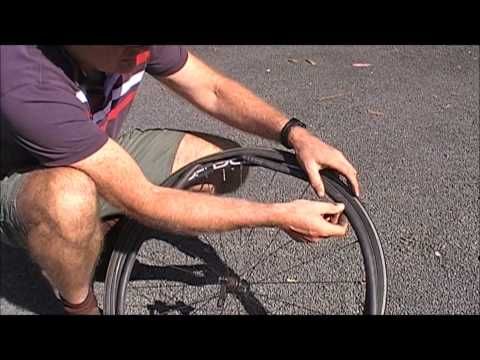Changing a bike tire after getting a flat is a relatively easy fix—as long as you know how to handle it. Whether you ride on smooth pavement, rough gravel, or rocky singletrack trails, it’s bound to happen eventually, so you might as well prepare yourself with both the necessary tools and the bike repair knowledge you need address the problem.
Below, we detail everything you need to know about how to change a bike tire, including the bike tire repair tips you need to succeed.
First things first though—for tools, you should always carry tire levers, a correctly-sized spare tube, and an inflation device, be it a mini pump or CO2 cartridge. You may also want to consider a patch kit or tire plug, which can come in handy for certain riders. And if you run tubeless tires, scroll down to skip to the tubeless section. When you’re ready to go, here’s your step-by-step guide.
Start by removing the wheel. Keep your bike upright, and if it’s a rear-wheel flat, shift your drivetrain into the hardest gear. If your bike has rim brakes, which many bikes still do, you may also need to loosen the brake.
Next, position yourself on the non-drive side of your bike (opposite the chain) and either open the quick release or unthread the thru-axle to remove the wheel.
Now you can remove the tire. Hook the rounded end of one tire lever under the bead (the outer edge) of the tire to unseat it. Fix the other end to a spoke to hold the lever in place and keep the unseated tire from popping back into the rim. Then hook the second lever under the bead next to the first, pushing it around the rim clockwise until one side of the tire is off. You don’t need to completely remove the tire.
Once the tire is loose, pull out the old tube (if applicable) and look for the source of the flat, which could be a thorn, piece of glass, or some other sharp object. Carefully run your fingers along the inside of your tire and rim, making sure nothing sharp is left behind; otherwise, you risk getting another flat. Also inspect the outside of the tire, again looking for any foreign object that might still be stuck in the rubber.
Carefully run your fingers along the inside of your tire and rim, making sure nothing sharp is left behind; otherwise, you risk getting another flat. Also inspect the outside of the tire, again looking for any foreign object that might still be stuck in the rubber.
If you’re using tubes and want to do a little detective work, pump some air into the old one to find the leak. Two holes side by side indicate a pinch-flat, where the tube gets pinched between the tire and rim. A single hole is a sign that your flat was most likely caused by a sharp object. By lining the tube up with the tire using the valve as a point of reference, you can double check the area where the hole is to ensure the culprit is removed.
If you’re the thrifty type who likes to reuse old tubes, or if you’ve gotten multiple flats on your ride and have no more spares, then you can patch your tube with a patch kit. If you have a new tube, skip to the next section.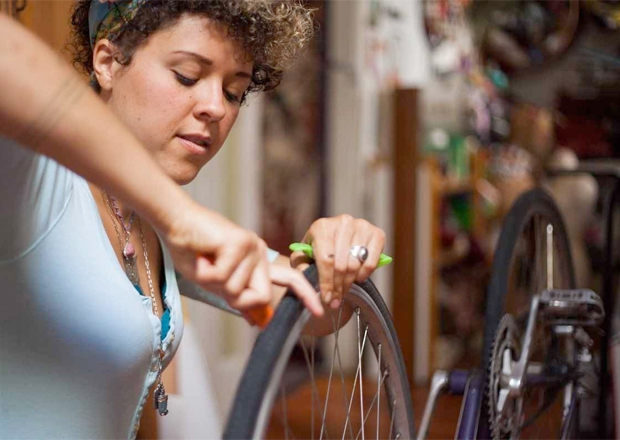
Start by cleaning the punctured area and roughing the surface with an emery cloth. For a glueless patch, simply stick it over the hole and press firmly. For a patch that requires glue, add a thin layer of glue to the tube and patch. Wait for the glue to get tacky, then apply the patch and press firmly until it adheres.
If you prefer to reuse old tubes or ran out of spares, you can try to patch the hole with a patch kit.
Katja Kircher//Getty ImagesNow inflate your new or patched tube just enough so that it holds its shape. This makes it easier to place inside the tire. Next, with the valve stem installed straight through the rim’s valve hole, position the tube inside the tire. Work the tire back onto the rim with your hands by rolling the bead away from yourself. Try not to use levers to reseat the tire, as you could accidentally puncture your new tube. When you get to the valve stem, tuck both sides of the tire bead low into the rim and push upward on the stem to get the tube inside the tire.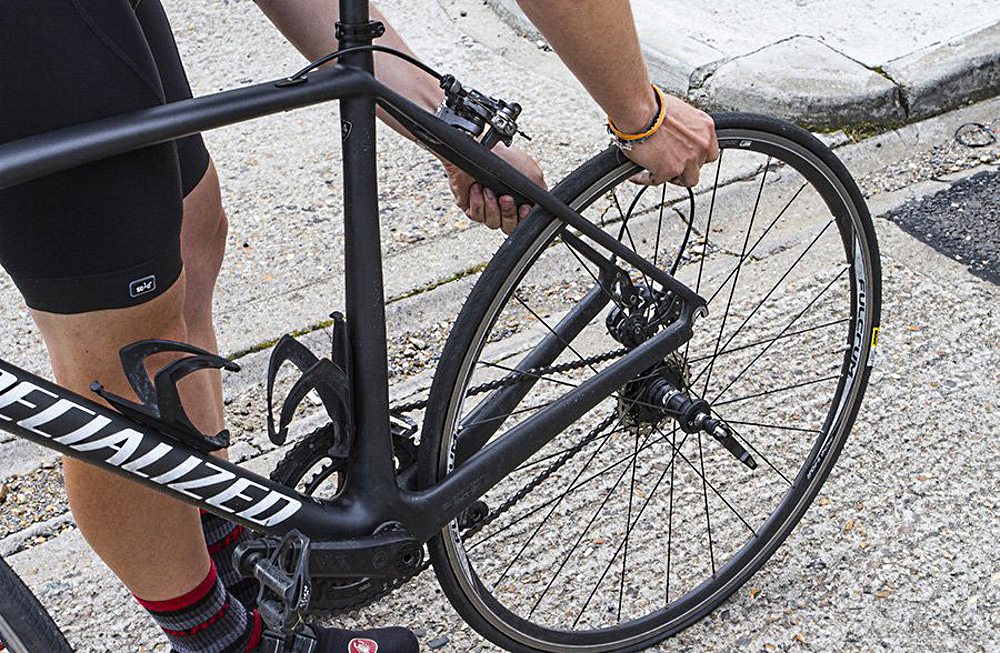
Check to make sure the tire bead isn’t pinching the tube by gently pushing the tire to the side as you work your way around the rim. Then inflate to the appropriate PSI and check that the bead is seated correctly.
$50 at Amazon
Credit: Silca$8 at Amazon
$6 at Amazon
Credit: Park Tool$37 at Walmart
Credit: REIIf everything looks good, reattach your wheel, making sure the quick release or thru-axle lever is on the opposite side of your drivetrain.
If you had a rear-wheel flat, lay the top of the chain around the smallest cog on your cassette and carefully push the wheel back into the frame. Close your quick release (and rim brakes if applicable) or insert the thru-axle back into the frame and hub and thread it closed.
Close your quick release (and rim brakes if applicable) or insert the thru-axle back into the frame and hub and thread it closed.
Finally, lift the rear wheel and spin your cranks once to make sure everything is back in place and operating smoothly. If all is good to go, get back on your bike and enjoy the rest of your ride.
Trevor Raab
For tubeless setups—all but standard in mountain biking and becoming increasingly popular on gravel, cyclocross, and even some road bikes—your sealant should do the trick without you even realizing it. Be sure to check your sealant regularly (about every three to six months) to make sure the tire has enough and that it hasn’t dried out.
But in the event of a bigger puncture or side-wall tear, you may need a tire plug to stop air loss. Plug kits come with a small strip of rubber and an insertion device, which allow you to plug the hole without even removing the wheel. Once you find the puncture and insert the rubber plug, re-inflate your tire to the appropriate pressure to see that it’s holding air. If so, start riding again, and check the repair every so often to make sure it’s holding fast. You could also add more sealant, but you’d need to carry a valve core removal tool and a small bottle of sealant.
Once you find the puncture and insert the rubber plug, re-inflate your tire to the appropriate pressure to see that it’s holding air. If so, start riding again, and check the repair every so often to make sure it’s holding fast. You could also add more sealant, but you’d need to carry a valve core removal tool and a small bottle of sealant.
Trevor Raab
If air loss is coming from a puncture bigger than a plug fix, you could try a patch or a boot on the tire. But fair warning: It’ll likely be difficult to get a patch to adhere to your sealant-coated tire without thoroughly cleaning the area. Adding more sealant or a patch could create another problem, too, by letting all the air out and breaking the seal between the rim and tire. It’ll likely be difficult to reseat the tire bead onto the rim on the spot. The easiest way to ensure your tire holds air at this point is to simply use a spare emergency tube to get through the ride and address it at home or at a bike shop.
$155 at Trek Bikes
$70 at Amazon
Keep It Clean
$10 at notubes.com
Precisely measure sealant and install with no mess.
Mid-Ride Repair
$60 at dynaplug.com
Brass-tipped plugs make fixing bigger punctures easy.
Jessica Coulon
Service and News Editor
When she’s not out riding her mountain bike, Jessica is an editor for Popular Mechanics. She was previously an editor for Bicycling magazine.
This content is imported from OpenWeb. You may be able to find the same content in another format, or you may be able to find more information, at their web site.
Home / Selle Anatomica Blog / What to Do About Fixing a Flat Bike Tire While out on a Ride
July 15, 2020
It’s a nightmare scenario for any cyclist: You’re halfway into a 50-mile ride when you suddenly begin to feel your wheel rumbling against the pavement. You pull off to the side to examine your tire, and your fears are confirmed. It’s a flat.
You pull off to the side to examine your tire, and your fears are confirmed. It’s a flat.
Now, if you had come prepared with the right supplies and experience fixing a flat bike tire, this would only be a minor nuisance. But as it is, you have neither, and now you’re stuck 25 miles from your car with no easy way to get back.
Most likely, you’d like to avoid this situation. And, since your chances of evading a flat tire are slim to none, it’s best to prepare yourself for the inevitable. Here again, our friend and cycling mentor Coach Darryl comes to save the day.
First things first—let’s get our terms straight.
“Everybody calls it a flat tire and it isn’t,” says Coach Darryl. “It’s actually a flat tube.” Unless you’re riding the rare tubeless road bike wheels or a fat-tired mountain bike, you’re going to be changing the tube on the inside of the tire, not the tire itself.
So why do these tubes go flat with that protective layer of thick rubber tire around them? When road cycling, Darryl notes, the culprit is usually a construction staple or wire, though sometimes it can be glass, a rock or just a big bump.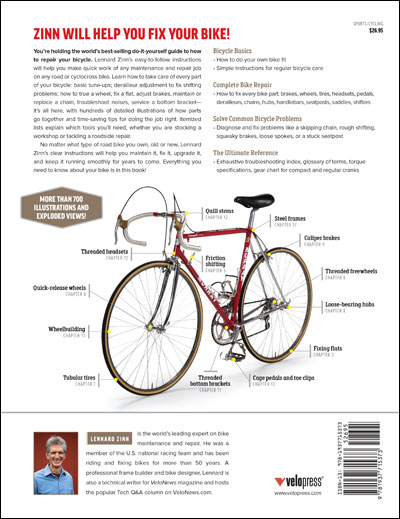
You’re most likely to have to fix a flat bike tire — or rather inner a flat tube — when it’s getting old, after the first 1,000 or 2,000 miles. As your narrow road tires wear down, the contact surface (where the tire touches the road) expands from a narrow point to a surface roughly 30% wider than it was. This wider contact area makes it that much easier to pick up a sharp object from the road. The tire also grows thinner, providing less of a protective barrier for the tube.
Occasionally, though, you can get a bad tire or tube (or you put the new one in wrong — we’ll get to that). If that’s the case, you’ll know it quickly, probably on the first ride. For this reason, Darryl recommends giving yourself a 10-day lead time to try out new tires before a big ride.
Bicycle flats are a fact of cycling life. In fact, you may get more than one on a long ride. Darryl once had six in one 25-mile ride. So, yeah, Coach always comes prepared.
He recommends bringing two spare tubes on a 30-to-45-mile ride, a third if you’re going more than 50 miles, and a fourth if you’re going over 100. You can stow these last two in your jersey pockets.
You can stow these last two in your jersey pockets.
Beyond the tubes, you should also bring several CO2 cartridges that you can use to refill your tire in a matter of seconds. Without these, you’re cranking a hand pump 200-plus times for several minutes. Yes, that’s as exhausting as it sounds. If you’re already invested in a long ride, you do not want to expend extra energy fixing a flat bike tire.
Do bring a hand pump as a backup, along with two valve adapters for your CO2 tanks and two tire levers (small plastic "tire irons” for prying the tire off the rim).
With the right equipment and a little know-how, you can change a flat bike tire and be back on your bike in 10 minutes. Here’s the step-by-step guide.
This should be the easy part, as most wheels these days are quick-release or through-axle (depending on your brake type). If your flat is on the back, though, be sure to change your gear to the smallest cog, furthest from the bike frame. Your derailleur will naturally spring to this position when you remove the chain, so that’s where you want it to be to make it easier to get the chain back on the wheel when you’re finished.
Your derailleur will naturally spring to this position when you remove the chain, so that’s where you want it to be to make it easier to get the chain back on the wheel when you’re finished.
Once you have the wheel off the bike, let any remaining air out of the tube so it’s easier to detach from the rim. With the air out, you’ll need your tire levers to remove the tire.
Starting at the opposite side of the valve stem, carefully use the pointed end of a tire lever to pry the tire and tube loose from the rim. If you encounter any resistance, use a second tire lever about three inches from the first, then pry at both points.
As it begins to separate, slowly move the tire lever around the tire, gently prying as you go, until you have the tire completely removed from the wheel.
Before you completely remove the flat tube, you need to find the hole. Otherwise, the object might still be in your tire, ready to puncture your new tube when you get back on the bike.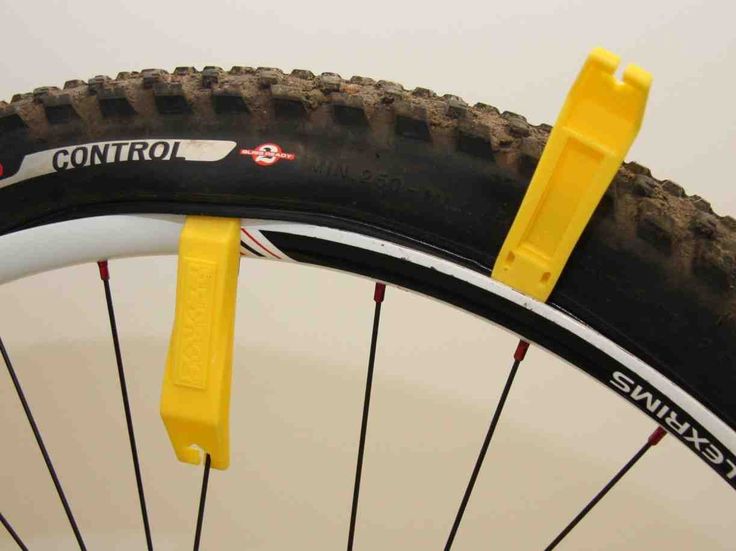
Starting furthest from the valve stem, pull the tube out of the tire all the way, leaving just 2 or 3 inches on either side of the valve. Once you find the hole, you can then line it up with the tire to see if the cause of your flat is still lodged there. Finding the cause is essential to ensure you fix your flat bike tire once from the initial cause.
With the flat tube hanging partially out, use a hand pump to blow it up just enough to hear where the air is leaking. If you have trouble hearing it, put your hand or your face close to the tube to feel the air seeping out. Darryl notes that, if you’re fairly certain that a bump was a cause, rather than something sharp, you can skip this step.
When you find the hole, line it up with the tire to find the culprit and remove it. In most cases, Coach Darryl says the tire will be ready to hold a new tube. In the rare instance that you have a damaged side wall, though, you can use an old piece of tire or even a folded dollar bill to cover the hole and prevent the new tube from forcing its way through and going flat.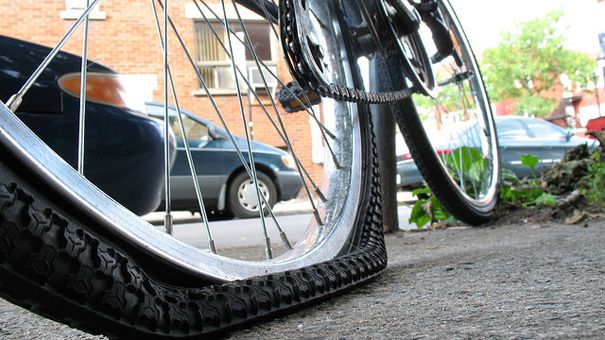 This isn’t a replacement for a new tire, mind you, but just enough to get you home or to a bike shop.
This isn’t a replacement for a new tire, mind you, but just enough to get you home or to a bike shop.
After you’re sure there’s nothing left in your tire to ruin your new tube, you can completely remove the old one. Before you begin to put the new tube in, blow it up just enough to give it its normal shape. This will keep it from getting twisted or folded when you seat it inside the tire.
Once it’s partially blown up, start by seating the valve stem where it fits, then work your way around from both sides of the valve to get the tube all the way inside the tire.
This is the hardest part of repairing a flat bicycle tire. You’ll start at the valve again here, pushing it up from the inside of the tire so that it pushes the tire higher than it would normally be on the road. This will give you enough clearance to get the tire around the rim first at the valve stem.
Now work your way around from both sides of the stem so that you’ll finish at the farthest point from it. Those last 8 inches or so are going to be the most difficult, and Darryl recommends keeping your gloves on and using your palms (not your thumbs) to push the tire onto the wheel. The hands are far stronger than the thumbs, and the gloves will protect your palms.
Those last 8 inches or so are going to be the most difficult, and Darryl recommends keeping your gloves on and using your palms (not your thumbs) to push the tire onto the wheel. The hands are far stronger than the thumbs, and the gloves will protect your palms.
Although some people use their tire levers to get those last few inches around, Coach Darryl cautions against this because you can inadvertently pinch your tube in the process.
It’s important not to rush past this part and start blowing up your tire. Slowly examine all the way around the wheel on both sides, looking for any sign that the tire isn’t seated right. There should be a ridge about 1/8 of an inch away above the rim all the way around. If this is too far out at any point or you see any tube sticking out around the edges, you need to adjust the tire.
Again, this is where those small CO2 cartridges will come in handy to save you time and effort. But be careful — these cartridges fill your tire so quickly that it’s easy to overfill and pop your tube. (Keep in mind, also, that you’ll probably need to refill the tire again when you get home, since the smaller CO2 molecules will leak out more quickly.)
But be careful — these cartridges fill your tire so quickly that it’s easy to overfill and pop your tube. (Keep in mind, also, that you’ll probably need to refill the tire again when you get home, since the smaller CO2 molecules will leak out more quickly.)
Attach the cartridge to the adaptor valve (the piece that connects it to the valve on the wheel), screwing it all the way in. Position the valve on your wheel toward the ground so you can apply pressure to the valve and not leak any CO2. Then tighten the other end of the valve adapter all the way onto the valve on the tire.
Unscrew the tank just enough to release the CO2 into your tire, while holding your hand on the tire to check the pressure as it fills. (The tanks frequently have more CO2 than will fit in your tire, so you can pop your new tube if you’re not careful.) As soon as your tire is full enough, tighten the tank back down to stop the air flow.
Give everything one more check to make sure the tire is seated correctly with no tube sticking out. If everything looks good, put your wheel back on your bike and you’re ready to ride.
If everything looks good, put your wheel back on your bike and you’re ready to ride.
And, finally, try the process of fixing a flat bike tire from the comfort of your home before you attempt it on the road. It’s best to get used to the process before you find yourself threatened with sunset or bad weather.
You can find more insights from Coach Darryl over at his website.
Share:
Please enable JavaScript to view the comments powered by Disqus.
contents
Basic steps to help you learn how to repair a puncture in the road

Other items…• July 13, 2020
How to fix a bike puncture in 7 easy steps
Although you might think that repairing a puncture can be expensive, it is actually one of the cheapest auto repair services. The price usually ranges from 6 to 20 euros, although they are usually around 10 euros.
The regulations also state that the area that can be repaired must be within the drawing, more specifically the center area of the tread. In addition, any puncture larger than 6 mm in diameter cannot be repaired.
A punctured tire can be repaired if:
The tire has a tread cut. The sharp object did not leave a large crack.
To apply bicycle patches, first use vulcanizing adhesive to seal the gap. Make sure you apply enough and wait a few minutes for the glue to dry. Position the patch so that it is fully attached to the tube.
The critical decision after applying the solution is to let the area dry for at least one or two hours, especially if it is hot and humid, because if we let it dry for just a few minutes and apply a patch, it will most likely dry. take longer or finish peeling early.
It usually takes 15 to 20 minutes to repair a puncture.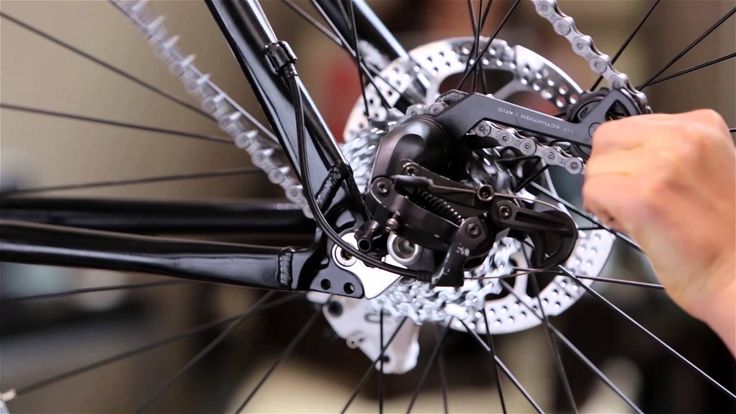 But the time will also depend on the complexion and the type of tire puncture.
But the time will also depend on the complexion and the type of tire puncture.
You can pay attention to the sound to listen for the exit of air, and use your sense of touch until you notice a change. There are those who dip the wheel into a bucket of water to quickly find the puncture site by looking at which area the bubbles are coming out of. When you find the perforated part, mark it with an X.
The cost of the patch is 50 pesos; vulcanized varies from 100 to 150 pesos.
Driving with a flat tire. Drive slower. Avoid driving faster than 24 to 32 mph (15 to 20 km/h) with a flat tire. You can cause irreparable damage to the metal wheel under the tire and even lose control of your vehicle.
What are vulcanized plasters? If there is a small puncture or superficial cut that does not compromise the safety of the wheel and therefore the vehicle, a vulcanized patch can be used, a method that is more durable and cheaper than a complete wheel replacement.
When the nail is deeply embedded, it works like a plug and prevents uncontrolled air leakage. If you don't have a spare tire and need to drive to the nearest store, this annoying nail can save you the trouble. Just leave it where it is and drive slowly towards the vulcanizer.
Patch: This is the most common method recommended by professionals because it is a quality solution. After examining the tire, the specialist puts a mushroom-shaped patch on the inside of it, which hermetically closes the cut.
Make. After you have been exposed to a needle stick or cut, wash the affected area with soap and water. If splashed into nose, mouth or skin, rinse with water. If such exposure occurs in the eyes, flush them with clean water, saline, or a sterile irrigator.
The presence of a lump or egg in the tire is a clear sign that the inner layers have suffered irreparable damage, it is the inner part of the tire, the radial structure that has undergone a rupture. The tire is supported by air or nitrogen pressure (better than the latter).
For bonding EPDM and natural rubber, a simple solution is to choose a special adhesive for bonding difficult rubber or rubbers, such as Permabond 105.
to patch | Definition | Spanish Dictionary | RAE - ASALE.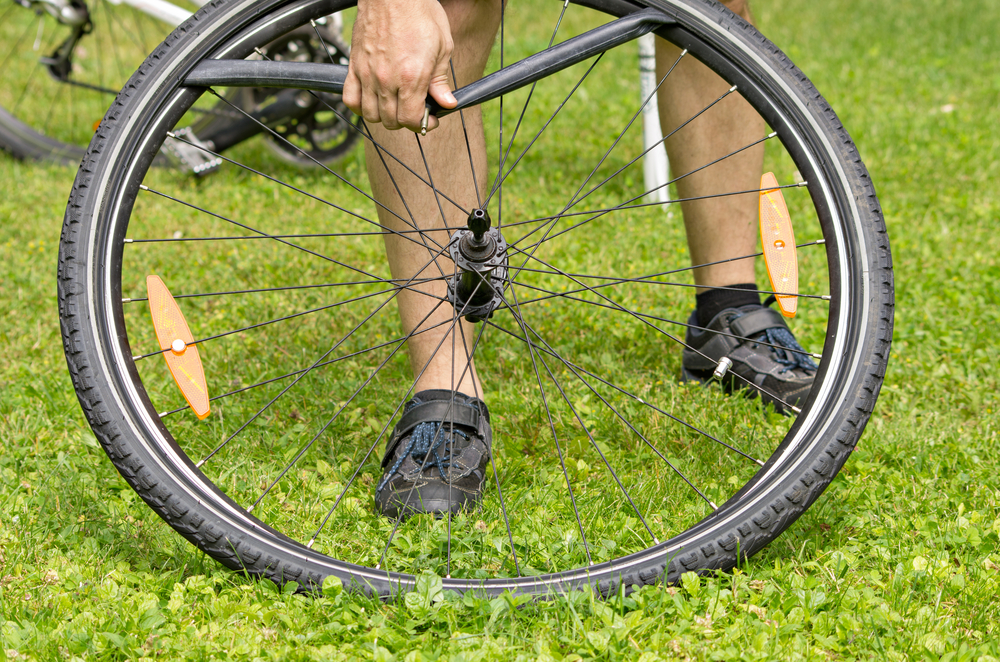 1. tr. patch (‖ install patches).
1. tr. patch (‖ install patches).
Plugs are a quick fix to prevent air from leaking out of a tire, but it's best to seal them to ensure a tight seal and safe repair.
It consists of a kit that you can find in auto accessory stores, it consists of a piece of rope with industrial adhesive that is added to a tire puncture with two simple tools, without using a jack or removing the tire.
Although some brands offer tires that promise to last around 10,000 km, in practice it is very likely that we will have to replace them when we get close to 3,500 km or about 3,200 km.
Insufficient tire pressure.
Too high pressure reduces tire grip; too low pressure allows the tube to pinch on impact (on a pothole, on a step), and rubbing the rubber against itself often causes holes in the tube.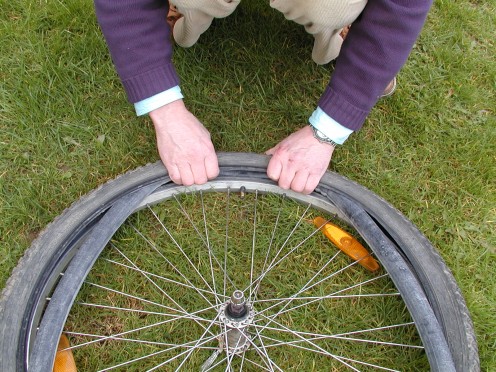
The answer is simple. It's just a matter of physics. Bicycle tire pressure is reduced due to the composition of the air containing nitrogen and oxygen. Be aware that a flat tire is not always synonymous with a puncture.
Usually the best solution when it comes to repairing small tubes and tires. Meanwhile, tire vulcanization is carried out on those tires that require processing at high temperatures and constant pressure in order to connect the molecules of the repairman and the tire.
What is a vulcanizer? Basically, it consists of two heavy metal strips, which are placed one on each side of the pre-prepared joint and firmly held together. Each strip heats up and this combined application of heat and pressure completes the bond over time.
Alignment is the process of adjusting the steering, suspension and tires of a vehicle, while balancing is the adjustment of the vehicle's balance of forces to prevent vibration and bouncing when making any turns.
Vulcanized hard rubber, sometimes sold under the brand names ebonite or vulcanite, is used to make hard objects such as bowling balls and saxophone mouthpieces. Uncured natural rubber is sticky, deforms easily when hot, and becomes brittle when cold.
A new tire tread can last up to 100,500 miles, but if the carcass is in good condition, you can potentially go up to 500 miles by vulcanizing it before you can't do it anymore.
Tire curing consists of heating the rubber and sulfur on the surface of the tire and applying pressure to either install a new tread band or repair tire damage.
- Insert file
This will require some effort as you will have to push it through the steel straps. Insert it into the tire with a twisting motion. Once you've gone through the reamer, insert it into and out of the tire a few times to make a good hole for the plug.
According to tire manufacturers such as Michelin, the average is around one puncture every 50.000 km, however everyone knows a driver who has never had a puncture and a driver who loses air from his tires every two to three .
It usually takes about a year for a tire to lose its minimum safe pressure, but if our vehicle has been exposed to extreme temperatures and the situation suddenly changes, the porosity can increase and lose more air than usual.
This is a patch with great flexibility. The upper part has a layer of butyl rubber, hence the name of the extra-hermetic lining; They have excellent heat resistance and adhesion to cushion rubber, allowing us to hot vulcanize them.
The needle itself can cause tissue damage as some are large and can become blunt and break off after repeated use (fig. 1). Injections with commonly used needles create a much higher risk of injury and infection.
1). Injections with commonly used needles create a much higher risk of injury and infection.
Although we think otherwise, a rear wheel puncture is more dangerous than a front one. It is easier to lose control of the car if the rear wheel blows than the front. An older tire is more prone to punctures and tears.
No, the typical egg on the side of a tire cannot be repaired. Moreover, this is one of the most dangerous damage that occurs in tires, as many users do not pay attention to it and continue to use the tire as it is, relying only on the condition of the tread.
When we hit our tire on the sides, be it pavement or any other element, the tire's internal fibrous structure breaks down and allows the pressure to push that area outward and these chips form.
Place the patch with the sticky side down and apply a hot iron to the fabric, pressing for about 30 seconds to ensure the adhesive adheres to the fabric.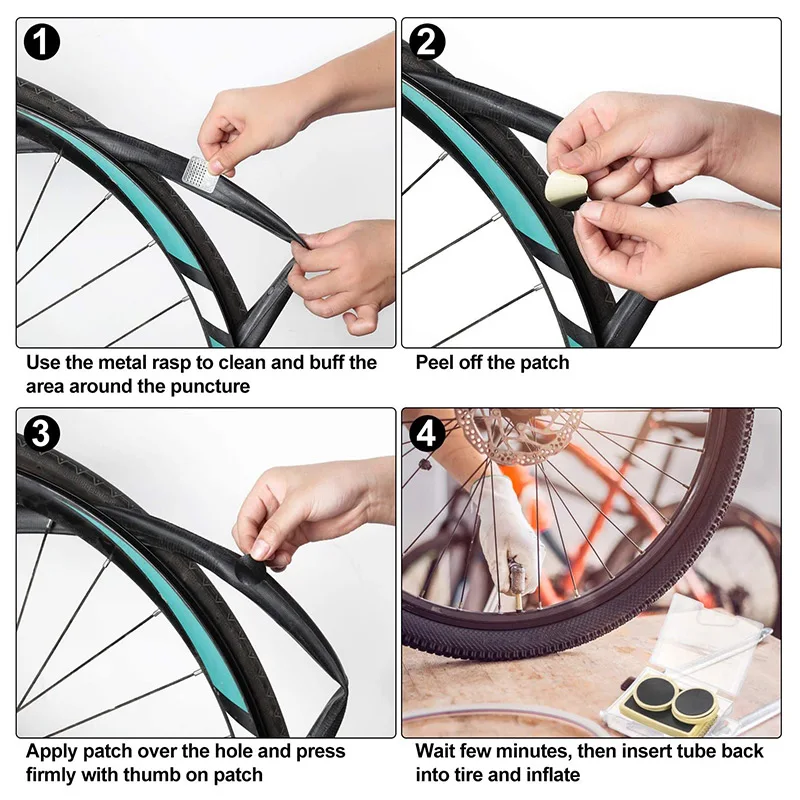
The easiest and best known way to reduce dark circles is to finely grate raw potatoes. Mix one or two grated potatoes, a tablespoon of flour and a tablespoon of milk, soak two cotton pads and place them under your eyes for 15 minutes. After the procedure, wash yourself with cold water.
Contents
Remove the wheel with a 15 mm wrench or by hand if the wheel is secured with a quick release. Use the tire levers to pull out the tire and tube. Using a bowler hat, inflate the pierced tube until you find where the air is escaping from. Sand the tube at the puncture site.
Although you might think that repairing a puncture can be expensive, it is actually one of the cheapest auto repair services. The price usually ranges from 6 to 20 euros, although they are usually around 10 euros.
A flat tire will increase friction and the speed must be constant in order for the vehicle to stay on track. Therefore, if possible, try to keep the car in a straight line while braking so that it stops itself.
Therefore, if possible, try to keep the car in a straight line while braking so that it stops itself.
How to patch a bicycle tire in 6 steps
The regulation states that tire repairs must be carried out within the central three-quarters of the drawing, called the “small repair area”. It is also not allowed to repair the tire if the puncture is equal to or greater than 6 mm in diameter.
It usually takes 15 to 20 minutes to repair a puncture. But the time will also depend on the complexion and the type of tire puncture.
But the time will also depend on the complexion and the type of tire puncture.
Driving with a flat tire. Drive slower. Avoid driving faster than 24 to 32 mph (15 to 20 km/h) with a flat tire. You can cause irreparable damage to the metal wheel under the tire and even lose control of your vehicle.
With these wheels you have to be careful both with speed and with kilometers covered. As for speed, we recommend that you do not exceed 80 km per hour. As for kilometers, the maximum is about 200. However, it is important to clarify that this will depend on the manufacturer.
The best thing in these cases is to put the vulcanized patch inside, a quick and safe repair, that is, in a workshop, that after a while the tires can lose air and be damaged, of course...
The critical decision after applying the solution is to let the area dry for at least one or two hours, especially if it is hot and humid, because if we let it dry for just a few minutes and apply a patch, it will most likely dry.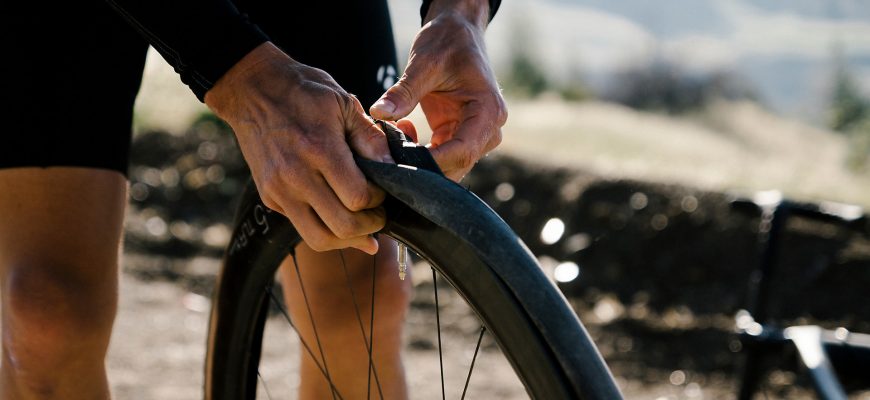 take longer or finish peeling early.
take longer or finish peeling early.
To apply bicycle patches, first use vulcanizing adhesive to seal the gap. Make sure you apply enough and wait a few minutes for the glue to dry. Position the patch so that it is fully attached to the tube.
Punctures that leave holes up to 6 mm in diameter in the tread are easily repaired. If the hole that caused the puncture is larger, it is best to replace the tire with a new one.
What are vulcanized plasters? If there is a small puncture or superficial cut that does not compromise the safety of the wheel and therefore the vehicle, a vulcanized patch can be used, a method that is more durable and cheaper than a complete wheel replacement.
Tire shop: what you need to know to open it.
The cost of tire repair depends largely on the type of damage. A punctured tire can be easily repaired with a vulcanizer and will cost no more than 200 pesos.
Sectional tires have a price range of 150 to 300 pesos depending on size and other conditions, so this can be a temporary measure to avoid the cost of a new tire.
Bicycle mechanics service and repair various makes and models of bicycles.
Common causes of chain breakage:
The chain is worn, bent, with tight links and/or excessively dirty. Excessive chain angle (large chainring - large chainring, small chainring - small chainring) Incorrect gear shifting. Do not use a chain that is compatible with chainrings and sprockets.
Do not use a chain that is compatible with chainrings and sprockets.
PUT THE BIKE AND IDENTIFY THE PROBLEM
Something we also need to check is that the pulley teeth are in good condition (no broken ones) and that the transmission is clean. Once this part is covered, we can move on to adjusting the bike derailleur.
Driving with an incorrectly inflated tire can cause a fatal accident. Insufficient pressure also leads to increased tire wear, reducing their service life to one year. Another major problem is fuel consumption.
It usually takes about a year for a tire to lose its minimum safe pressure, but if our vehicle has been exposed to extreme temperatures and the situation suddenly changes, the porosity can increase and lose more air than usual.
Be aware that tires can lose air due to differential pressure, this effect is called the permeation process and affects all tires, regardless of type or application, since the joints that make up the tire are not completely sealed, and their porosity allows . ..
..
You will notice how it wears, especially if it takes time at less pressure than recommended. Transportation of a tire in a flat state increases the wear of its outer edges, the shoulder areas of the tire. You will also notice that the tire is hotter than the others.
According to tire manufacturers such as Michelin, the average is around one puncture every 50.000 km, however everyone knows a driver who has never had a puncture and a driver who loses air from his tires every two to three .
This is a patch with great flexibility. The upper part has a layer of butyl rubber, hence the name of the extra-hermetic lining; They have excellent heat resistance and adhesion to cushion rubber, allowing us to hot vulcanize them.
Engine mounts, also known as engine mounts, are rubber parts with a metal base. Inside the car, they are extremely important elements, as they act as a link between the engine and the chassis.
Inside the car, they are extremely important elements, as they act as a link between the engine and the chassis.
Apply a hot iron to the bottom of the patch for 30 seconds to a minute. If necessary, turn the garment inside out to get to the bottom of the patch. Pry off the edge of the patch with the blade of a butter knife. Grasp the edge of the patch and slowly peel it off the fabric.
to patch | Definition | Spanish Dictionary | RAE - ASALE. 1. tr. patch (‖ install patches).
The patch is usually applied to the skin once every 7 days. Every time you change your patch, change it around the same time. Follow the directions on the prescription label carefully and ask your doctor or pharmacist to explain any part you don't understand.
If you notice that your contraceptive patch has come off before 24 hours of placement, try putting it on, but if that's not possible because it keeps peeling off, replace it with another one and continue with your regular band change day.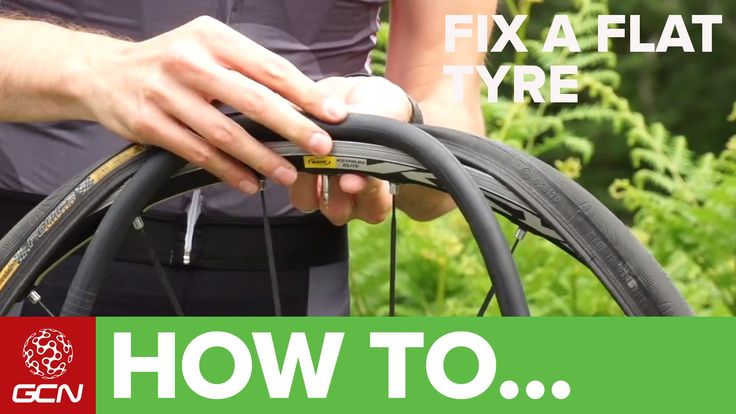 In this case, the patch change date does not change.
In this case, the patch change date does not change.
Some patches differ from others mainly because of the way the drug is stored and how it is released.
From this point of view, there are three main types of transdermal patches:
STEP BY STEP HOW TO APPLY A PATCH/APPLIQUE ON A CAP?
Precurex X Patch Cement 250 gr.
These are adhesives based on phenolic resins. These adhesives instantly react to interaction with the surrounding air and dry quickly.
Some Internet sellers of tires indicate that the average price Spaniards will pay to replace the wheels of motorcycles, scooters and mopeds will be 18 euros in 2022.
VIDEO: This is the basic maintenance of your car. It is recommended not to drive more than 200 kilometers with this spare wheel.
A new tire tread can last up to 100,500 miles, but if the carcass is in good condition, you can potentially go up to 500 miles by vulcanizing it before you can't do it anymore.
Tire curing consists of heating the rubber and sulfur on the surface of the tire and applying pressure to either install a new tread band or repair tire damage.
Vulcanized hard rubber, sometimes sold under the brand names ebonite or vulcanite, is used to make hard objects such as bowling balls and saxophone mouthpieces. Uncured natural rubber is sticky, deforms easily when hot, and becomes brittle when cold.
How much does it cost to fix a flat tire? While you might think that puncture repair can be expensive, it is actually one of the cheapest auto repair services.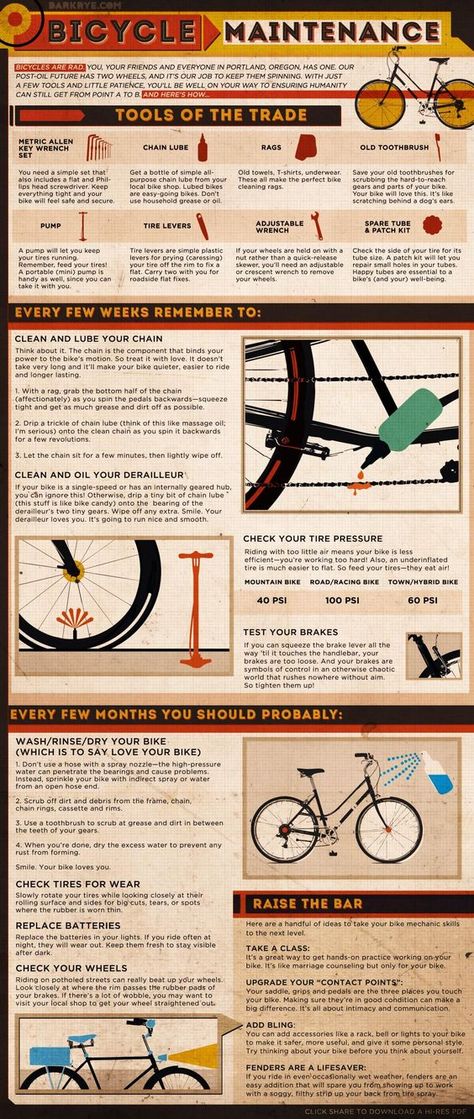 The price usually ranges from 6 to 20 euros, although they are usually around 10 euros.
The price usually ranges from 6 to 20 euros, although they are usually around 10 euros.
To avoid this and keep your tires in good condition, here are five signs that you need new tires.
The presence of a lump or egg in the tire is a clear sign that the inner layers have suffered irreparable damage, it is the inner part of the tire, the radial structure that has undergone a rupture. The tire is supported by air or nitrogen pressure (better than the latter).
In general, discs can be repaired in 90% of cases, when there are only scratches and small bumps. On the other hand, if the structure has been broken or has cracks, warpage (warping), lack of material and deep damage, it is advisable to purchase a new one.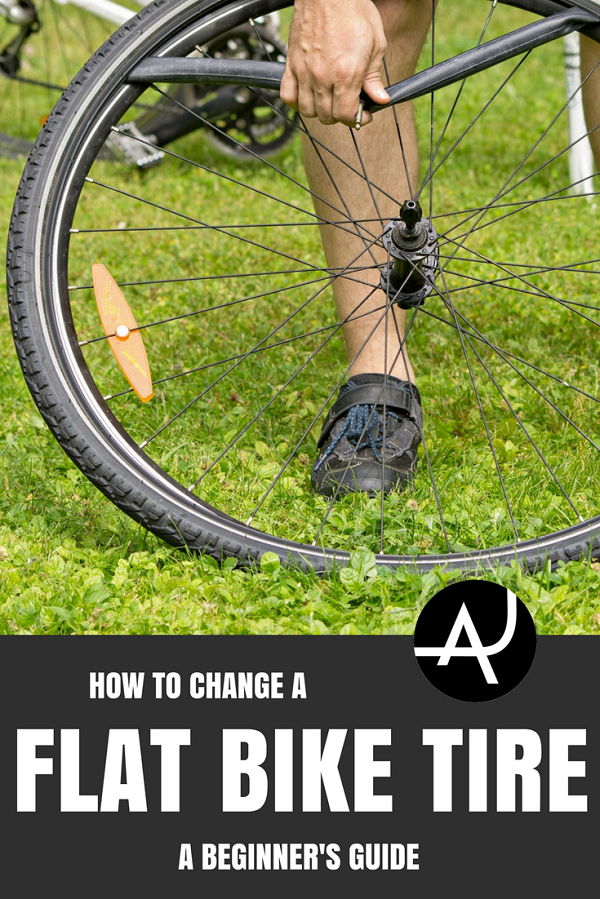
Below we detail the prices for the main events: Bicycles. Wheel trim costs $200 to $300, brake repairs are $200, and a patch is $80.
“Talacha costs no more than 80 pesos, it depends on the workshop, it is a simple job that does not require much labor,” said mechanic Raul Velazquez.
Some online tire sellers indicate that the average price Spaniards will pay to replace the wheels of motorcycles, scooters and mopeds will be 18 euros in 2022.
The cost of tire repair depends largely on the type of damage. A punctured tire can be easily repaired with a vulcanizer and will cost no more than 200 pesos.
How much does a flat tire repair cost?
Repairing a tire at a tire shop or mechanic usually costs between 5 and 40 euros for a standard tire and between 30 and 60 euros for repairing a flat racing tire (designed for safe driving even if punctured).